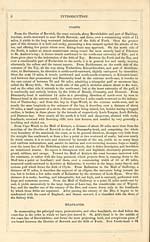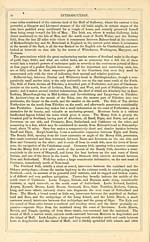Download files
Complete book:
Individual page:
Thumbnail gallery: Grid view | List view

INTRODUCTION.
miles to the north-west. WMtberry-head and Gulane-point, are in Haddingtonshire, —
the latter some distance within the frith of Forth. Fifeness, a low, sandy, naked headland,
is the termination of the peninsula of Fife. Buddonness, similar to the former, and Red-head,
a beetling and bold promontory, are in Forfarshire. Todhead, Garron-point, Finnonness, and
Girdleness, are in Kincardineshire, — the last at the mouth of the Dee, and at the end of a
range of the Grampians. Buchanness is the most easterly land in Aberdeenshire, and even
in Scotland. Rattray-point, Cairnbulg-head, and Kinnaird-head, are in the same county, — .
the two last at the entrance of the Moray frith. Knock-head is in Banffshire. Coulard-
hill and Burgh-head are in Elginshire. Chanonry-point, at the entrance of the Beauly frith,
is in Ross-shire. Cromarty-point, at the entrance of the Cromarty frith, and Tarbatness, the
termination of the long narrow peninsula between the Cromarty and the Dornoch friths,
belong to Cromartyshire. Ord of Caithness, Clytheness, Noss-head, Duncansby-head, Dun-
net-head, and Holborn-head, are in Caithness, — the three last looking across the Pentland
frith to the Orkney Islands. Strathey-point, Whiten-head, Far-out-head, Cape- Wrath, and
Assynt-point, are in Sutherlandshire, — the last on its west coast, and the three first on its
north. Rhu-more is on the west coast of Cromarty. Udrigal-head, and Rhu-Rea-head, are
on the west coast of Ross-shire. Ardnamurchan-point, the most westerly ground on the
mainland, — the Mull of Kintyre, at the entrance of the Clyde, and of the Irish channel, —
and Lamont-point and Toward-point, the southern terminations on the east and the west of
the district of Cowal, on the Clyde, — are in Argyleshire. Clough-point, on the Clyde, is in
Renfrewshire. Kirkcolm-point, at the entrance of Loch-Ryan, — Corsewall-point, at the north-
west extremity of the Rhinns of Galloway, — and the Mull of Galloway and Burrow-head, at
the southern extremities of Scotland, — are in Wigtonshire. Ross-head, between Wigton and
Kirkcudbright bays, — Balcarry-point, at the west side of Auchencairn-bay, — Almerness-point,
between that bay and the estuary of the Urr, — and Southerness-point, at the extreme south
east of Galloway, — are in Kirkcudbrightshire.
MARINE WATERS.
The German ocean, where it washes the mainland of Scotland, is closed up on the east
side by Denmark, the entrance to the Baltic, and Christiansand in Norway. The North sea
and the German ocean, where they girdle the northern and western shores, are — as we shall
afterwards see — thickly occupied by the archipelagoes of Scotland, and both tamed in the
fury of their billows, and to a considerable extent stripped of their superincumbent vapours,
by the numerous and boldly screening islands, before they reach the main shore. From just
the same circumstance, too, or owing to currents, whirlpools, shoals, rocks, valuable winds,
and intricacy of channel, among the girdlings of the islands, or between them and the main-
land, these seas are not a little difficult and dangerous of navigation. And, owing to the
gullets and narrow sounds, which serve like funnels for the wind between high grounds, and
to the great number and magnitude and power of the rocky or mountainous obstructions
which are presented to the breeze and the tide, and to the labyrinth of paths, and the posi-
tions of successive or alternate propulsion, vexation, opposition, and becalming which have to
be traversed by a current, the seas likewise exhibit in the frequent storms of winter, or amidst
a gale on the longest and far extending day of the hyperborean summer, scenes of awful sub-
limity, which would appal almost any sensitive person except a native of the islands or of the
mainland sea-board. The Irish channel, where it washes the Mull of Kintyre, looks up the
frith of Clyde, and sweeps along the Rhinns of Galloway from Corsewall-point to the Mull
of Galloway, is curtained on its west or south-west side by the county of Antrim, the entrance
of Belfast loch, and the county of Down in Ireland, is 13 miles broad at the Mull of Kintyre,
and 21 at Portpatrick, and may be viewed as having an average breadtli along Wigtonshire
of 24 or 25 miles. At the point where it expands into the Irish sea, or immediately off the
Mull of Galloway, the tides, which come in one slow and majestic current across the Atlantic,
which encounter the long, vast obstruction of Ireland, and which sweep round the ends of
that country into the Irish sea by the opposite inlets at the Mull of Kintyre and at St.
George's-channel, run against each other in a tumult of collision, and produce, even in calm
weather, a tumbling, troughy sea, which no landsman loves to traverse. Resulting from the
same causes, the tidal currents in the adjacent parts of the Irish sea, and above all in the
Solway frith, are the most curious in the world. Some miles southward of the Galloway
coast, where the efflux is felt from both the Galloway estuaries and the Solway frith, or even
miles to the north-west. WMtberry-head and Gulane-point, are in Haddingtonshire, —
the latter some distance within the frith of Forth. Fifeness, a low, sandy, naked headland,
is the termination of the peninsula of Fife. Buddonness, similar to the former, and Red-head,
a beetling and bold promontory, are in Forfarshire. Todhead, Garron-point, Finnonness, and
Girdleness, are in Kincardineshire, — the last at the mouth of the Dee, and at the end of a
range of the Grampians. Buchanness is the most easterly land in Aberdeenshire, and even
in Scotland. Rattray-point, Cairnbulg-head, and Kinnaird-head, are in the same county, — .
the two last at the entrance of the Moray frith. Knock-head is in Banffshire. Coulard-
hill and Burgh-head are in Elginshire. Chanonry-point, at the entrance of the Beauly frith,
is in Ross-shire. Cromarty-point, at the entrance of the Cromarty frith, and Tarbatness, the
termination of the long narrow peninsula between the Cromarty and the Dornoch friths,
belong to Cromartyshire. Ord of Caithness, Clytheness, Noss-head, Duncansby-head, Dun-
net-head, and Holborn-head, are in Caithness, — the three last looking across the Pentland
frith to the Orkney Islands. Strathey-point, Whiten-head, Far-out-head, Cape- Wrath, and
Assynt-point, are in Sutherlandshire, — the last on its west coast, and the three first on its
north. Rhu-more is on the west coast of Cromarty. Udrigal-head, and Rhu-Rea-head, are
on the west coast of Ross-shire. Ardnamurchan-point, the most westerly ground on the
mainland, — the Mull of Kintyre, at the entrance of the Clyde, and of the Irish channel, —
and Lamont-point and Toward-point, the southern terminations on the east and the west of
the district of Cowal, on the Clyde, — are in Argyleshire. Clough-point, on the Clyde, is in
Renfrewshire. Kirkcolm-point, at the entrance of Loch-Ryan, — Corsewall-point, at the north-
west extremity of the Rhinns of Galloway, — and the Mull of Galloway and Burrow-head, at
the southern extremities of Scotland, — are in Wigtonshire. Ross-head, between Wigton and
Kirkcudbright bays, — Balcarry-point, at the west side of Auchencairn-bay, — Almerness-point,
between that bay and the estuary of the Urr, — and Southerness-point, at the extreme south
east of Galloway, — are in Kirkcudbrightshire.
MARINE WATERS.
The German ocean, where it washes the mainland of Scotland, is closed up on the east
side by Denmark, the entrance to the Baltic, and Christiansand in Norway. The North sea
and the German ocean, where they girdle the northern and western shores, are — as we shall
afterwards see — thickly occupied by the archipelagoes of Scotland, and both tamed in the
fury of their billows, and to a considerable extent stripped of their superincumbent vapours,
by the numerous and boldly screening islands, before they reach the main shore. From just
the same circumstance, too, or owing to currents, whirlpools, shoals, rocks, valuable winds,
and intricacy of channel, among the girdlings of the islands, or between them and the main-
land, these seas are not a little difficult and dangerous of navigation. And, owing to the
gullets and narrow sounds, which serve like funnels for the wind between high grounds, and
to the great number and magnitude and power of the rocky or mountainous obstructions
which are presented to the breeze and the tide, and to the labyrinth of paths, and the posi-
tions of successive or alternate propulsion, vexation, opposition, and becalming which have to
be traversed by a current, the seas likewise exhibit in the frequent storms of winter, or amidst
a gale on the longest and far extending day of the hyperborean summer, scenes of awful sub-
limity, which would appal almost any sensitive person except a native of the islands or of the
mainland sea-board. The Irish channel, where it washes the Mull of Kintyre, looks up the
frith of Clyde, and sweeps along the Rhinns of Galloway from Corsewall-point to the Mull
of Galloway, is curtained on its west or south-west side by the county of Antrim, the entrance
of Belfast loch, and the county of Down in Ireland, is 13 miles broad at the Mull of Kintyre,
and 21 at Portpatrick, and may be viewed as having an average breadtli along Wigtonshire
of 24 or 25 miles. At the point where it expands into the Irish sea, or immediately off the
Mull of Galloway, the tides, which come in one slow and majestic current across the Atlantic,
which encounter the long, vast obstruction of Ireland, and which sweep round the ends of
that country into the Irish sea by the opposite inlets at the Mull of Kintyre and at St.
George's-channel, run against each other in a tumult of collision, and produce, even in calm
weather, a tumbling, troughy sea, which no landsman loves to traverse. Resulting from the
same causes, the tidal currents in the adjacent parts of the Irish sea, and above all in the
Solway frith, are the most curious in the world. Some miles southward of the Galloway
coast, where the efflux is felt from both the Galloway estuaries and the Solway frith, or even
Set display mode to: Large image | Transcription
Images and transcriptions on this page, including medium image downloads, may be used under the Creative Commons Attribution 4.0 International Licence unless otherwise stated. ![]()
| Gazetteers of Scotland, 1803-1901 > Imperial gazeteer of Scotland, or, Dictionary of Scottish topography > Volume 1 > (17) Page iii |
|---|
| Permanent URL | https://digital.nls.uk/97459334 |
|---|
| Description | Volume I: Aan-Gordon. |
|---|---|
| Attribution and copyright: |
|

